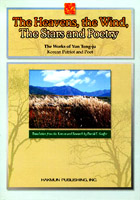 Yun Dong-ju is often known as a poet and patriot. He was arrested by the Japanese more than once, and was a firm believer in conserving important element of Korean culture during Japanese colonialism. There is some suspicion that his death might have been the result of Japanese medical experimentation (191).
Yun Dong-ju is often known as a poet and patriot. He was arrested by the Japanese more than once, and was a firm believer in conserving important element of Korean culture during Japanese colonialism. There is some suspicion that his death might have been the result of Japanese medical experimentation (191).
The Heavens, the Wind, The Stars and Poetry is an omnibus type book. It contains 120 poems, a short biogrphay, and excellent frontispiece photo, a 19 page analysis of his poetry, and an interesting bit of “research” into the religious basis of his work.
But also included in the book are four short stories, of which three are very short. Not surprising for a poet, the works are full of allusion and symbols, with nature taking a very high rank in that list of allusions and symbols. This can be pretty easily noted just by looking at the titles of his short stories. Yun is a complicated read as well, hopping from thing to thing with little notice and employing a writing style that is in some ways reminiscent of the surrealism of Yi Sang and the absurdity of Pak Min-gyu. That’s good territory to be in, if you don’t know the authors.^^
Shooting at the Moon begins with a typical rush of lyricism – the narrator arising, a partner sleeping, notices nature outside and the window that separates it from the inside. What is really inside, however, are the thoughts of a letter the narrator has received. The letter has a similar kind of lyricism based on nature, and it discusses a breakup between the two. The narrator finds himself outside, and wonders if he came out the window. More thought, and more nature is used in a metaphor of hope, hopelessness, or re-dedication. It is difficult to tell, which is likely what Yun wanted.
The structure is really that of a poem, with an introductory stanza, an explanatory one, and a cathartic one, and it might even read best if thought of that way.
The second work, Where the Falling Star Drops, is even briefer than the first. Its themes are similar, beginning with a contemplation of nature. Again, the narrator seems uncertain, even of existing. The narrator contemplates his relationship with a tree, and the uncertainty of life before seeing a signal which he takes as the indication of a path.
Flowers Bloom in the Flower Garden is short, difficult to read, but worth it. The story itself addresses the difficulty of writing, at least one word is missing, and there is at least one pretty obvious error in translation. Still, it is a touching meditation on life and nature set in the anodyne arenas of the classroom and garden.
There may also be a certain admission of why he is a poet when his character (him, really, as he formally addresses his ‘reader’) says. “I still come up with only a few lines of writing. So for me writing is not such an enjoyable task.”
Sijo calls.^^
At the end, the tone is reflective as the entire last paragraph is “By the fireside many things will realized.”
The End and the Beginning, by far the longest of Yun’s four stories here, continues the discussion of the previous story between studying, or learning, and simply being in the world. It is also Buddhist in a cyclical and sometimes Manichean kind of way. It is also the most difficult to read, as its length seems to exceeds Yun’s ability to keep a plot going – this, again, likely a function of his essential skill as a poet. It is best read as a kaleidoscopic and surreal mental landscape of a person on the bus. This, the notes in the book reveal, may be exactly what it is.^^
Pick this book up for the poetry, if you like translated Korean poetry, but also spare a moment to consider the short fiction as a noble, and often successful attempt to extend the poetic imagination to prose.


